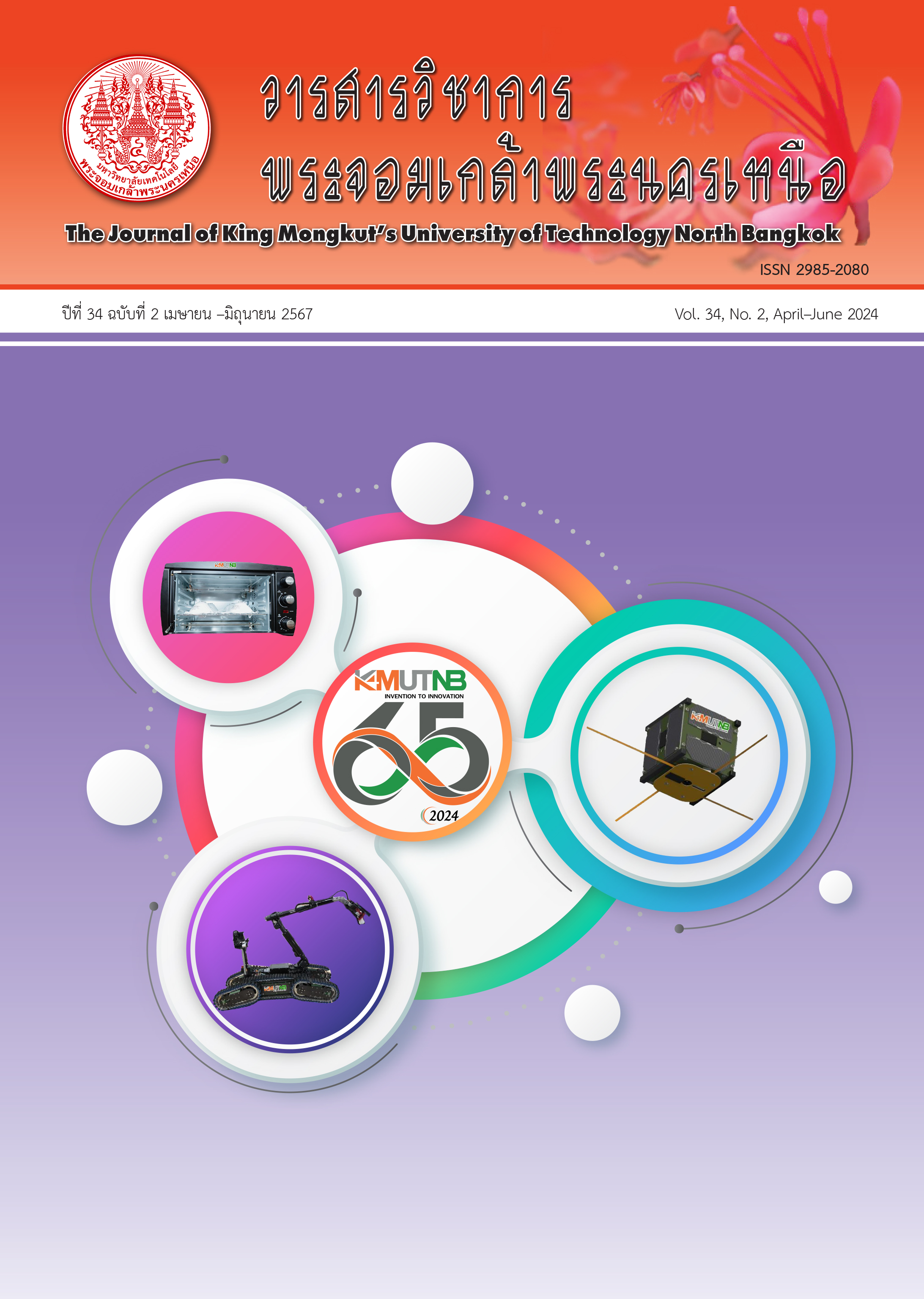Optimization of Submerged Fermentation for Ganoderma lucidum Mycelium in Longan Juice
Main Article Content
Abstract
Longan is an agricultural product of northern Thailand with high yields, low prices, and a lack of innovation to add value. In the Covid–19 situation, there is a need for food to stimulate immunity, so longan was used as a source of energy for Ganoderma lucidum fungi for growth and mycelium production. The objective of this research was to determine the optimum conditions for fermentation of Ganoderma lucidum mycelium in longan juice. The factors were the quantity of 9 brix longan juice, sucrose, skim milk, CaCO3, KH2PO4, MgSO4.7H2O and inoculate culture. Variables by Plackett Burman Design method, optimal range by the Steepest ascent method and optimization by the response surface method were used in the statistical analysis. It was found that 9 brix longan juice (251. 549 ml/ l) and skim milk (14. 226 g/ l) were important factors and produced the highest dry weight of Ganoderma lucidum mycelium at 36. 636 g/ l while the other composition of the medium used in submerged fermentation was as follows: 7. 5 g/ l sucrose, 0. 6 g/ l CaCO3, 0. 75 g/ l KH2PO4, 0.75 g/l MgSO4.7H2O, and 50 ml/l inoculate culture. This research can be applied in functional beverages, food supplements and natural immune-boosting products.
Article Details

This work is licensed under a Creative Commons Attribution-NonCommercial-NoDerivatives 4.0 International License.
The articles published are the opinion of the author only. The author is responsible for any legal consequences. That may arise from that article.
References
T. Gan, C. Feng, H. Lan, R. Yang, J. Zhang, C. Li, and W. Li, “Comparison of the structure and immunomodulatory activity of polysaccharides from fresh and dried longan,” Journal of Functional Foods, vol. 76, Art. no. 104323, 2021.
C. Somjai, T. Siriwoharn, K. Kulprachakarn, S. Chaipoot, R. Phongphisutthinant, W. Chaiyana, S. Srinuanpan, and P. Wiriyacharee, “Effect of drying process and long-term storage on characterization of Longan pulps and their biological aspects: Antioxidant and cholinesterase inhibition activities,” LWTFood Science and Technology, vol. 154, Art. no. 112692, 2022.
Y. H. Tseng, J. H. Yang, and J. L. Mau, “Antioxidant properties of polysaccharides from Ganoderma tsugae,” Food Chemistry, vol. 107, no. 2, pp. 732–738, 2008.
X. B. Mao, T. Eksriwong, S. Chauvatcharin and, J. J. Zhong, “Optimization of carbon source and carbon/nitrogen ratio for cordycepin production by submerged cultivation of medicinal mushroom Cordyceps militaris,” Process Biochemistry, vol. 40, no. 5, pp. 1667– 1672, 2005.
K. I. Lin, Y. Y. Kao, H. K. Kuo, W. B. Yang, A. Chou, H. H. Lin, A. L. Yu, and C. H. Wong, “Reishi polysaccharides induce immunoglobulin production through the TLR4/TLR2-mediated induction of transcription factor blimp-1,” Journal of Biological Chemistry, vol. 281, no. 34, pp. 24111–24123, 2006.
K. Arunachalam, S. P. Sasidharan, and X. Yang, “A concise review of mushrooms antiviral and immunomodulatory properties that may combat against COVID-19,” Food Chemistry Advances, vol. 1, Art. no. 100023, 2022.
J. P. Balamurugan, S. Supramani, S. R. A. Usuldin, Z. Ilham, A. Klaus, N. K. K. Ikram, R. Ahmad, and W. A. A. Q. I. Wan-Mohtar, “Efficient biomass-endopolysaccharide production from an identified wild-Serbian Ganoderma applanatum strain BGS6Ap mycelium in a controlled submerged fermentation,” Biocatalysis and Agricultural Biotechnology, vol. 37, Art. no. 102166, 2021.
N. A. Hassan, S. Supramani, M. N. A. Sohedein, S. R. A. Usuldin, A. Klaus, Z. Ilham, W. H. Chen, and W. A. A. Q. I. Wan-Mohtar, “Efficient biomass-exopolysaccharide production from an identified wild-Serbian Ganoderma lucidum strain BGF4A1 mycelium in a controlled submerged fermentation,” Biocatalysis and Agricultural Biotechnology, vol. 21, Art. no. 101305, 2019.
S. Jinendiran, D. Kumar, H. U. Dahms, C. D. Arulanandam, and N. Sivakumar, “Optimization of submerged fermentation process for improved production of β-carotene by Exiguobacterium acetylicum S01,” Heliyon, vol. 5, no. 5, Art. no. e01730, 2019.
N. Narkprasom, J. H. Guo, T. C. Huang, and Y. K. Guu, “Combination of statistical techniques for submerged fermentation for extracellular polysaccharide and biomass of Ganoderma tsugae,” American Journal of Biostatistics, vol. 3, no. 2, pp. 38–46, 2013.
T. Luo, L. Shua, T. Lai, L. Liao, J. Li, Z. Duan, X. Xue, D. Han, and Z. Wu, “Up-regulated glycolysis, TCA, fermentation and energy metabolism promoted the sugar receding in ‘Shixia’ longan (Dimocarpus longan Lour.) pulp,” Scientia Horticulturae, vol. 281, Art. no. 109998, 2021.
X. F. Zhang, S. Guo, C. T. Ho, and N. S. Bai, “Phytochemical constituents and biological activities of longan (Dimocarpus longan Lour.) fruit: A review,” Food Science and Human Wellness, vol. 9, no. 2, pp. 95–102, 2020.
M. Y. Chang, G. J. Tsai, and J. Y. Houng, “Optimization of the medium composition for the submerged culture of Ganoderma lucidum by Taguchi array design and steepest ascent method,” Enzyme and Microbial Technology, vol. 38, no. 3–4, pp. 407–414, 2006.
M. l. Cui, H. Y. Yang and G. Q. He, “Submerged fermentation production and characterization of intracellular triterpenoids from Ganoderma lucidum using HPLC-ESI-MS,” Journal of Zhejiang University-SCIENCE B (Biomedicine & Biotechnology), no. 16, pp. 998–1010, 2015.
Y. J. Tang, . W. Zhang, R. S. Liu, L. W. Zhu, and J. J. Zhong, “Scale-up study on the fed-batch fermentation of Ganoderma lucidum for the hyperproduction of ganoderic acid and Ganoderma polysaccharides,” Process Biochemistry, vol. 46, no. 1, pp. 404–408, 2011.
J. Zhang, J. J. Zhong, and A. Geng, “Improvement of ganoderic acid production by fermentation of Ganoderma lucidum with cellulase as an elicitor,” Process Biochemistry, vol. 49, no. 10, pp. 1580–1586, 2014.

